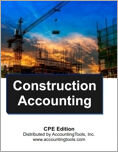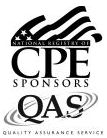Construction Accounting (CPE Course)
CPE Credit: 11 hours
Course Type: Downloaded PDF materials with online test
Price (with PDF Textbook): $75
Course Description
This course addresses every aspect of the accounting for a construction business. The intent is to not only explain accounting concepts, but also provide examples and show how an accounting system can be constructed and operated. The course pays particular attention to unique aspects of construction accounting that are not encountered in other industries, including the job cost ledger, change orders, back charges, percentage of completion calculations, and the treatment of anticipated losses on contracts. In short, Construction Accounting is the go-to source for information about the accounting for a construction firm.
Author: Steven Bragg
Course Number: AC1109
Table of Contents
Chapter 1. Overview of the Construction Industry
Chapter 2. The Construction Accounting System
Chapter 3. Construction-Specific Accounting
Chapter 4. Construction Transactions
Chapter 5. Construction Financial Statements
Chapter 6. Fixed Asset Accounting
Chapter 7. Payables Accounting
Chapter 8. Debt Accounting
Chapter 9. Contingencies
Chapter 10. Lease Accounting
Chapter 11. Payroll Accounting
Chapter 12. Investments in Construction Joint Ventures
Chapter 13. Construction Tax Issues
Chapter 14. Construction Accounting Controls
Chapter 15. Job Analysis
Chapter 16. Business Structures
Learning Objectives
Recognize the types of bonds that a contractor may be required to post.
Cite the different types of clauses that may be added to a construction contract.
Specify the various causes of contract claims.
Specify the types of financial difficulties to which the construction industry is subjected.
Identify the different types of ledgers used by a construction company.
Specify the components of a work breakdown structure.
Recognize the types of accounts most likely to be designated as control accounts by a contractor.
Recognize the linkage between contracts and revenue recognition.
State the criteria for the existence of a contract.
Specify the methods used to determine the price of a contract.
Cite the criteria used to identify contract fulfillment costs.
Recognize the different methods used to calculate the percentage of completion.
Identify the situations in which the completed contract method should be used.
Describe the circumstances under which the recovery of funds from a change order is probable.
Specify the proper accounting for pre-contract costs.
Describe the normal account balances for the various account types.
Recognize when the straight-line rent concept should be applied.
Recognize the uses to which the accounting equation is put.
Identify the linkage between the balance sheet and the income statement.
Identify the impact of a long operating cycle.
Cite the circumstances under which the useful life concept is employed.
Specify the significance of the mid-month convention.
Identify the depreciation calculations for all depreciation methods.
Recognize the accounting for the disposition of a fixed asset.
Specify the methods available for giving meaning to a supplier identification number.
Recognize the purpose of the different copies of the Form 1099-MISC.
Specify the purpose of the more important boxes listed on the Form 1099-MISC.
Recognize the reasons for loan balance differences in the records of the lender and borrower.
Cite the rule used for determining the amount of a loss contingency accrual.
Specify the proper disclosure for the different types of contingent losses.
Specify the uses for the lessee of a lease arrangement.
Recognize the lease rules related to short-term lease arrangements.
Describe the usage of the Form W-4.
Identify the calculation used for the hourly rate plan.
Specify how the wage bracket method is used.
Recognize the payment schedules for the different types of tax deposits.
Identify the tax calculation for the FUTA tax.
Recognize how the equity method is calculated.
Specify the IRS designation for a multi-year contract.
Recognize the circumstances under which the IRS allows the cash method to be used.
Recognize the circumstances under which the completed contract method is used to recognize revenue.
Identify the situations in which a change log can be most profitably used.
Recognize the controls that apply to fixed fee and cost plus contracts.
Cite the components of earned value management.
Describe the calculation of the cost performance index.
Specify the advantages and disadvantages of the various types of organizational structures, as well as the requirements for the formation of each one.
Level: Overview
Instructional Method: QAS Self-Study
NASBA Category: Accounting
Prerequisites: None
Advance Preparation: None
Latest Review Date: April 2024
Program Registration Requirements: Click on "Purchase Course" near the top of this page to pay for and access the course. You will then be able to download the course as a PDF file, then take an on-line examination, and then download a certificate of completion if you pass the examination.
Program Refund Policy: For more information regarding administrative policies concerning complaints, refunds, and other matters, see our policies page.
AccountingTools, Inc. is registered with the National Association of State Boards of Accountancy (NASBA) as a sponsor of continuing professional education on the National Registry of CPE Sponsors. State boards of accountancy have the final authority on the acceptance of individual courses for CPE credit. Complaints regarding registered sponsors may be submitted to the National Registry of CPE Sponsors through its website: www.nasbaregistry.org.
The NASBA sponsor identification number for Accountingtools, Inc. is 115881.
AccountingTools is an IRS Approved Continuing Education Provider. We are compliant with the requirements for continuing education providers (as described in sections 10.6 and 10.9 of the Department of Treasury’s Circular No. 230 and in other IRS guidance, forms, and instructions). Our IRS Approved Continuing Education Provider number is 72821.


